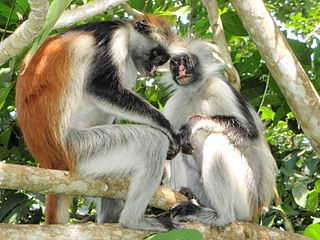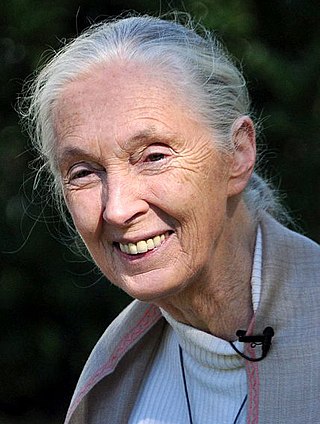Related Research Articles

The chimpanzee, also known as simply the chimp, is a species of great ape native to the forest and savannah of tropical Africa. It has four confirmed subspecies and a fifth proposed one. When its close relative the bonobo was more commonly known as the pygmy chimpanzee, this species was often called the common chimpanzee or the robust chimpanzee. The chimpanzee and the bonobo are the only species in the genus Pan. Evidence from fossils and DNA sequencing shows that Pan is a sister taxon to the human lineage and is humans' closest living relative. The chimpanzee is covered in coarse black hair, but has a bare face, fingers, toes, palms of the hands, and soles of the feet. It is larger and more robust than the bonobo, weighing 40–70 kg (88–154 lb) for males and 27–50 kg (60–110 lb) for females and standing 150 cm.

Dame Jane Morris Goodall, formerly Baroness Jane van Lawick-Goodall, is an English primatologist and anthropologist. She is considered the world's foremost expert on chimpanzees, after 60 years studying the social and family interactions of wild chimpanzees. Goodall first went to Gombe Stream National Park in Tanzania to observe its chimpanzees in 1960.

The genus Pan consists of two extant species: the chimpanzee and the bonobo. Taxonomically, these two ape species are collectively termed panins. The two species were formerly collectively called "chimpanzees" or "chimps"; if bonobos were recognized as a separate group at all, they were referred to as "pygmy chimpanzees". Together with humans, gorillas, and orangutans they are part of the family Hominidae. Native to sub-Saharan Africa, chimpanzees and bonobos are currently both found in the Congo jungle, while only the chimpanzee is also found further north in West Africa. Both species are listed as endangered on the IUCN Red List of Threatened Species, and in 2017 the Convention on Migratory Species selected the chimpanzee for special protection.
Charlotte Jane Uhlenbroek is a British zoologist and BBC television presenter.
Gombe may refer to:

Gombe Stream National Park is a national park in Kigoma District of Kigoma Region in Tanzania, 16 km (10 mi) north of Kigoma, the capital of Kigoma Region. Established in 1968, it is one of the smallest national parks in Tanzania, with only 35 km2 (13.5 sq mi) of protected land along the hills of the eastern shore of Lake Tanganyika. The terrain is distinguished by steep valleys, and the vegetation ranges from grassland to woodland to tropical rainforest. Accessible only by boat, the park is most famous as the location where Jane Goodall pioneered her behavioural research on the common chimpanzee populations. The Kasakela chimpanzee community, featured in several books and documentaries, lives in Gombe National Park.

Richard Walter Wrangham is an English anthropologist and primatologist; he is Professor of Biological Anthropology at Harvard University. His research and writing have involved ape behavior, human evolution, violence, and cooking.

Red colobuses are Old World monkeys of the genus Piliocolobus. It was formerly considered a subgenus within the genus Procolobus, which is now restricted to the olive colobus. They are closely related to the black-and-white colobus monkeys, and some species are often found in groups with the blue monkey. The western red colobus is frequently hunted by the common chimpanzee.

Mahale Mountains National Park lies on the eastern shore of Lake Tanganyika in Uvinza District of Kigoma Region, Tanzania. Named after the Mahale Mountains range that is within its borders, the park has several unusual characteristics. First, it is one of only two protected areas for chimpanzees in the country. Mahale Mountains National Park harbours the largest known population of eastern chimpanzees and due to its size and remoteness, the chimpanzees flourish. It also a place where chimpanzees and lions co-exist. Another unusual feature of the park is that it is one of the very few in Africa that must be experienced by foot. There are no roads or other infrastructure within the park boundaries, and the only way in and out of the park is via boat on the lake.

Hugo Arndt Rodolf, Baron van Lawick was a Dutch wildlife filmmaker and photographer.

The Jane Goodall Institute (JGI) is a global non-profit wildlife and environment conservation organization headquartered in Washington, DC. It was founded in 1977 by English primatologist Jane Goodall and Genevieve di San Faustino (1919-2011). The institute's mission is to improve the treatment and understanding of primates through public education and legal representation, to protect their habitats in partnership with local communities, and to recruit and train young people for these missions.
The Jane Goodall Institute (Hong Kong) (Chinese: 國際珍古德(香港)協會), founded in 2002, was established as a local registered charity involved in the promotion of the well-being of the community, animals and environment. The Jane Goodall Institute Hong Kong is one of the Asian branches of the Jane Goodall Institute which was founded in 1977 in California by Jane Goodall and Genevieve, Princess di San Faustino. With its headquarters in the US, the Jane Goodall Institute is a worldwide non-profit organization with 17 overseas offices.

The eastern chimpanzee is a subspecies of the common chimpanzee. It is native to the Central African Republic, South Sudan, the Democratic Republic of the Congo, Uganda, Rwanda, Burundi, and Tanzania.

The central chimpanzee or the tschego is a subspecies of chimpanzee closely related to the other great apes such as gorillas, orangutans, and humans. The central chimpanzee can be found in Central Africa, mostly in Gabon, Cameroon, Republic of Congo and the Democratic Republic of Congo.
Barbara Boardman Smuts is an American anthropologist and psychologist noted for her research into baboons, dolphins, and chimpanzees, and a Professor Emeritus at University of Michigan, Ann Arbor.
The Kasekela chimpanzee community is a habituated community of wild eastern chimpanzees that lives in Gombe National Park near Lake Tanganyika in Tanzania. The community was the subject of Jane Goodall's pioneering study that began in 1960, and studies have continued ever since, becoming the longest continuous study of any animals in their natural habitat. As a result, the community has been instrumental in the study of chimpanzees and has been popularized in several books and documentaries. The community's popularity was enhanced by Goodall's practice of giving names to the chimpanzees she was observing, in contrast to the typical scientific practice of identifying the subjects by number. Goodall generally used a naming convention in which infants were given names starting with the same letter as their mother, allowing the recognition of matrilineal lines.

Toshisada Nishida was a Japanese primatologist who established one of the first long term chimpanzee field research sites. He was the first to discover that chimpanzees, instead of forming nuclear family-like arrangements, live a communal life with territorial boundaries. His discoveries of the medicinal use of plants by wild chimpanzees helped form the basis of the field of zoopharmacognosy.
The Gombe Chimpanzee War, also known as the Four-Year War, was a violent conflict between two communities of chimpanzees in Gombe Stream National Park in the Kigoma region of Tanzania between 1974 and 1978. The two groups were once unified in the Kasakela community. By 1974, researcher Jane Goodall noticed the community splintering. Over a span of eight months, a large party of chimpanzees separated themselves into the southern area of Kasakela and were renamed the Kahama community. The separatists consisted of six adult males, three adult females and their young. The Kasakela was left with eight adult males, twelve adult females and their young.
Anne Elizabeth Pusey is director of the Jane Goodall Institute Research Center and a professor of evolutionary anthropology at Duke University. Since the early 1990s, Pusey has been archiving the data collected from the Gombe chimpanzee project. The collection housed at Duke University consists of a computerized database that Pusey oversees. In addition to archiving Jane Goodall’s research from Gombe, she is involved in field study and advising students at Gombe. She was elected a member of the National Academy of Sciences in 2022.

Jane is a 2017 American biographical documentary film directed and written by Brett Morgen about primatologist, ethologist, and anthropologist Jane Goodall. It makes use of footage filmed by Hugo van Lawick that was rediscovered in 2014.
References
- ↑ Craig B. Stanford (1998). Chimpanzee and Red Colobus: The Ecology of Predator and Prey . Harvard University Press. ISBN 9780674116672.
- 1 2 Jane Goodall (2010). Through a Window: My Thirty Years with the Chimpanzees of Gombe. Houghton Mifflin Harcourt. ISBN 9780547488387.
- ↑ Michael Lawrence Wilson (2014-07-10). "Mitumba" . Retrieved 2015-01-12.
- 1 2 3 Deus Cyprian Mjungu (July 2010). "Dynamics of intergroup competition in two neighboring chimpanzee communities" (PDF). University of Minnesota. Retrieved 2016-12-22.
- 1 2 Michael Lawrence Wilson (2012). "Long-term Studies of the Chimpanzees of Gombe National Park, Tanzania". In Peter M. Kappeler; David P. Watts (eds.). Long-term Field Studies of Primates. Springer. pp. 357–384. ISBN 9783642225130.
- 1 2 Anup Shah; Fiona Rogers (2014). Tales from Gombe. Firefly. pp. 319–320. ISBN 9781770854680.
- 1 2 3 Pusey, A; Murray, C; Wallauer, W; Wilson, M; Wroblewski, E; Goodall, J. Severe Aggression Among Female Pan troglodytes schweinfurthii at Gombe National Park, Tanzania (PDF). VIVAMUS.